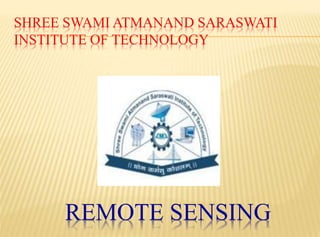
Remote sensing
- 1. REMOTE SENSING SHREE SWAMI ATMANAND SARASWATI INSTITUTE OF TECHNOLOGY
- 2. PREPARED BY: Prof. Karm Balar
- 3. REMOTE SENSING(GIS) Definition of Remote sensing Advantages Of Remote sensing Elements of Remote sensing Limitation of Remote sensing Principal Of Remote Sensing
- 4. DEFINITION OF REMOTE SENSING Remote sensing is the science of gathering information from a location that is distant from the data source. Image analysis is the science of interpreting specific criteria from a remotely sensed image. assistance of computer enhancement, extract information from an image, whetherit is furnished in the form of an aerial photograph, a multispectral satellite scene, a, radar image, a base of LIDAR data, or a thermal scan.
- 5. HOW TO WORK REMOTE SENSING
- 6. ADVANTAGES OF SATELLITE SCENES Presuming that the inherent accuracy of satellite data conforms to the mapping specification demands, satellite data can be a valuable tool in many ways.
- 7. REMOTE SENSING (1) Active: E’ emitted and return is measured (e.g., radar, sonar)
- 8. PICTORIAL IMAGE CHANGE DETECTION Satellite raster imagery provides a pictorial simulation that can be overlaid on GIS/LIS vector themes so that the viewer can see the image and line drawing simultaneously. Hardcopy plots of the image data can be created. satellite imagery for different pasHistorical ses over the same site is available for purchase. Change detection information can be gleaned from these time-lapse scenes.
- 10. SATELLITE SYSTEMS Geostationary Satellite in equatorial orbit at 36,000 km altitude stays over the same spot Satellite Polar-Orbiting Satellite about 850 km altitude travels over both north and south poles. Earth rotates ~13° for each ~100 min orbit can see whole globe at high resolution Sees only small portion
- 11. Landsat 1 (1972) 3 m high; 1.5 m diameter 890 kg solar cells 1.2 x 2.4 m 3-axis stabilized multi-spectral scanner return beam vision viewed continuous strip of 185 km. scan mirror oscillated 13 times a second
- 12. Land sat a Multi- Spectral Scanner images of Rondonia, Brazil at higher resolution show the detailed interaction of development and deforestation. Resolution of these images is 80 m.
- 13. Cloud parameters Dark gray clouds in IR photograph represent the highest and thickest clouds Individual storms show as dark patches surrounded by light regions A. Visible (reflected) B . Infra-Red (E=sT4)
- 14. LIMITATION OF REMOTE SENSING I. remote sensing system the variation in classes to be discriminated is expressed by the distribution of their member populations in spectral space, e.g., as illustrated in two bands, II. b1, b2. The extent of overlap between two classes expresses their fundamental inseparability.
- 16. Variation in different components of the system, such as benthic class spectral variation, variance in water clarity, or sensor noise, contributes to variation in the recorded signal.sensor limited objectives are those for which change in sensor
- 17. PASSIVE & ACTIVE REMOTE SENSING
- 18. PRINCIPLES OF REMOTE SENSING Detection and discrimination of objects or surface features means detecting and recording of radiant energy reflected or emitted by objects or surface material (Fig. 1). Different objects return different amount of energy in different bands of the electromagnetic spectrum, incident upon it. This depends on the property of material (structural, chemical, and physical), surface roughness, angle of incidence, intensity, and wavelength of radiant energy. The Remote Sensing is basically a multi-disciplinary science which includes a combination of various disciplines such as optics, spectroscopy, photography, computer, electronics and telecommunication, satellite launching etc. All these
- 19. STAGES IN REMOTE SENSING • Emission of electromagnetic radiation, or EMR (sun/self- emission) • Transmission of energy from the source to the surface of the earth, as well as absorption and scattering • Interaction of EMR with the earth’s surface: reflection and emission • Transmission of energy from the surface to the remote sensor • Sensor data output
- 20. REMOTE SENSING PROCESS What we see At temperature above absolute zero, all objects radiate electromagnetic energy by virtue of their atomic and molecular oscillations. The total amount of emitted radiation increases with the body’s absolute temperature and peaks at progressively shorter wavelengths. The sun, being a major source of energy, radiation and illumination, allows capturing reflected light with conventional (and some not-so-conventional) cameras and films.
- 21. MODERN REMOTE SENSING TECHNOLOGY VERSUS CONVENTIONALAERIAL The use of different and extended portions of the electromagnetic spectrum, development in sensor technology, different platforms for remote sensing (spacecraft, in addition to aircraft), emphasize on the use of spectral information as compared to spatial information, advancement in image processing and enhancement techniques, and automated image analysis in addition to manual interpretation are points for
- 22. THANK YOU
